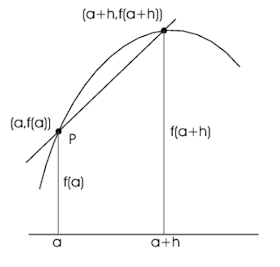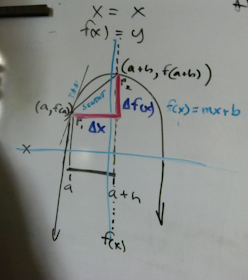I was working with an AP calc student. They are just getting started. As usual the student did not see the relationships between what we had done before and the formulas he was getting. When I showed him these side by side with a brief explanation the tell tale "OHHHHHH!" was exclaimed (the light bulb going on / the rush of endorphins when you understand something) and he said, "well, that's easy then." Base ten blocks give a solid foundation so that when we get to this point many obstacles to understanding have already been mastered and are not issues. Understanding square numbers and square root for example and trig which is basically the study of how triangles work is made plain using base ten blocks...no one ever explained to me in highs chool that math was a language and how all those formulas were basically saying the same thing and how and when to apply them. It was basically just memorize this, this and this...and I never got the relationships between them until years later.
Desmos.
This student comes once in a blue moon. If he came on a regular basis I wouldn't have to hit him over the head with it as it were and he would see that we are just finding the slope of a line, as well as see Pythagoras not only in distance formula but in the basic trig identity too. In the last formula we talked about h being more than just h it's the distance between the a and a+h expressed using economy of symbol. (The thick black line below the red lines in the last pic below.)
He might also see our old friend from the doughnut factory and playing with ordered pairs rise over run for rate and slope and the "m" in y = mx + b or as he will now see it f(x) = mx + b where m = dy/dx....but all these triangles do go together....and it's pretty easy to see that even the complicated looking formula with a's and h's and stuff isn't so hard after all. The basics are covered on vids and on password protected pages like this. Look for Water tank, doughnut factory constant rate problems.
Then tangent lines and secant lines are no problem either and with a little more explanation of economy of symbol and that y = f(x) and how we just labeled the points with letters, the anxiety subsides rather rapidly and learning can take place. It's hard to learn anything while in flight or fight response. We have proven this time and time again. It's pretty obvious that the secant and the tangent lines are going to need different formulas. Average slope between those two points is going to be less accurate the further the points are from each other and more accurate the closer those to points are together. His online textbook actually had some cool gifs and animations that really helped explain things. That link goes to a page that has an animation on the bottom give it a few seconds to load.
Now this and the formulas that came with aren't thought of as hard anymore and we can play and fool around with the concepts. If I want to know the distance between those points of course I use distance formula, if I want to know the slope of that line then I need to know dy/dx but now instead of just x and y, I have x and f(x) or in this case the points are labeled [a, f(a)] and [a+h, f(a+h)] but it's really just x and y...and secant and tangent and limits and intervals are all just language to describe what's going on here. But what if I don't want an average? What if I don't want the "as a crow flies" answer but the actual length of that curved line? Well I need more math and this guy named Newton came along and gave us more math, we call it calculus.
We can also find the tangent line to point P or any point along the curve. Tangent Line = Instantaneous Rate of Change = Derivative. That line would be "outside" the curve not under it....speaking generally.
 Some more explanations and drawing make the general concepts understood. Here we can see the curve being analyzed a little further. See the triangle shaping up in the corner there?
Some more explanations and drawing make the general concepts understood. Here we can see the curve being analyzed a little further. See the triangle shaping up in the corner there? We are going to use symbols to describe that triangle and the part we are interested in is the hypotenuse, but in order to find the hypotenuse which is the average slope of the curve between those two points we need to know the sides which are the changes or distances between x and y.
Secant line = Average Rate of Change = Slope. Simple.
Add more information and it looks more complicated but actually there is MORE understanding taking place, not less...but you don't want to come in at the end...or in the middle which I find is where most text books start, instead of starting at the beginning. I can also usually find the "holes" in the students mathematics that are making it hard. Sometimes those holes go all the way back to not understanding division or fractions. Lots of times a review of triangles and Pythagoras is in order.
Now I've added labels for the axis and put more info in blue the tan line and the secant line and the basic formula for it, the axis of symmetry is the dotted line and we can see that the tan line and secant line are not the same thing so we will need different formulas to describe them.
At last it becomes absolutely clear that we are just playing with triangles and those fancy formulas are just talking about the sides of the triangle...and all of this is in very general terms we are just playing with concepts. Next we will add numbers instead of just having the distance between a and a +h we'll have numbers that tell us what (where) a is and how far it is to a + h. We'll get an quadratic expression that describes the curve and from that we do lots of math. We can also find the area under that curve between a and a+h and we can be quite exact about it. But that's a lesson for another day...and the blocks will come in really handy here too. Because how are we going to do that? By making and summing up rectangles...
Meantime we talked about limits and derivatives and how tan and secant lines differ and how to think about things in general and specific terms depending on the symbols. We talked about the power rule a lot and the chain rule a little bit and I showed him how the power rule works and what it means.





No comments:
Post a Comment